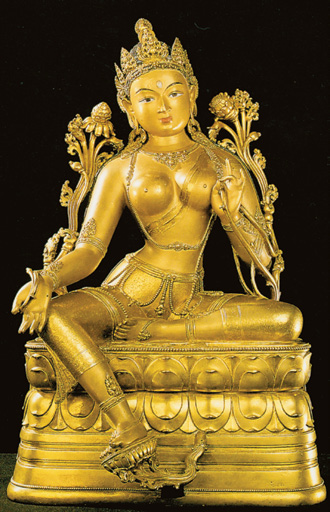An Illustrated Outline of Buddhism: The Essentials of Buddhist Spirituality (29 page)
Read An Illustrated Outline of Buddhism: The Essentials of Buddhist Spirituality Online
Authors: William Stoddart,Joseph A. Fitzgerald
Tags: #Philosophy

Rinchen Zangpo (tenth century) [“the Great Translator”]
Atīsha Dipamkara Shrī Jñāna [Indian] (eleventh century)
Koncho Gyepo Khön (eleventh century)—
Sakya
order—“Gray Earth”
Tilopa [Indian] (tenth century)
↓
Nāropa [Indian] (eleventh century)
↓
Marpa (eleventh century)
Kagyü
order
[“the Translator”]
↓
&
Milarepa (eleventh century)
Karma-Kagyü
order—“Black Hats”
Tsongkhapa (fourteenth-fifteenth century)—
Gelug
order—“Yellow Hats”
He who knoweth the precepts by heart, but faileth to practice
them, is like unto one who lighteth a lamp and then shutteth his
eyes.
The Ocean of Light for the Wise


Tibet
93
iii. Tantra
In Buddhism, there are not only the
Hīnayāna
and
Mahāyāna
schools.
There is also a branch of
Mahāyāna
,
namely
Vajrayāna
or
Tantrayāna
,
which, because of its importance, is called the “Third School” or the
“Third Setting in Motion of the Wheel of the Law”.
Vajrayāna
spread
from India to Tibet in the eleventh century, and became of particular
importance in the latter country.
Buddhism in general looks on the world as an exile; it sees it under
its negative aspect of corruptibility and temptation—and so of suffering.
Tantra
,
on the contrary, sees the world positively as theophany or sym-
bol; it sees through the forms to the essences. Its spiritual way is union
with the celestial archetypes of created things. In the words of Frithjof
Schuon: “
Tantra
is
the spiritualization—or interiorization—of beauty,
and also of natural pleasures, by virtue of the metaphysical transpar-
ency of phenomena. In a word:
Tantra
is
nobility of sentiments and
experiences; it excludes all excess and goes hand in hand with sobriety;
it is a sense of archetypes, a return to essences and primordiality.”2
The metaphysical doctrine and spiritual practice of
tantra
is
based
on the masculine and feminine principles or “poles”, known in Vedānta
as
purusha
and
prakriti.
In Hinduism, these are represented or symbol-
ized by Shiva and his Consort (
Shakti
)
Kali. In
Mahāyāna
Buddhism
in general, and in Tibetan Buddhism in particular, the masculine and
feminine principles appear in the form of the following pairs:
Masculine
Feminine
Upāya
(“Formal doctrine and method”)
Prajñā
(“Formless wisdom”)
Vajra
(“Lightning”, “Diamond”)
Garbha
(“Womb”)
Dorje
(“Thunderbolt scepter”)
Drilbu
(“Handbell”)
Mani
(“Jewel”)
Padma
(“Lotus”)
YAB (“Father”)
YUM (“Mother”)
intellectuality
spirituality
2 Unpublished text, no. 1042.

94
An Illustrated Outline of Buddhism
This polarity (and its resolution) evokes the doctrine implicit in one of
the Hindu names for God, namely
Sat-Chit-Ānanda
,
often translated
as “Being-Consciousness-Bliss”.
In divinis
this Ternary means “Object-
Subject-Union” and, spiritual y or operatively, it can be rendered as
“Beloved-Lover-Love” and other analogous ternaries:
Sat
Being Object Beloved Invoked Known
Chit
Consciousness Subject Lover Invoker Knower
Ānanda
Bliss Union Love Invocation Knowledge
In this context, the first row is seen as the “feminine” element
(
prajñā
),
the second row as the “masculine” element (
upāya
),
and the third row as the union between them (
sukha
).
Metaphysical y, it can be said that
samsāra
(the world) “is”
Nirvāna
(the Divine State). This is because Reality is one, and the Principle of
samsāra
is
Nirvāna.
Also, and for the same reason, the distinction can be
bridged in unitive prayer: “The Kingdom of Heaven is within you.” For
fallen man, however, the situation is quite different:
samsāra
is very far
from
Nirvāna
.
Hence the Buddha’s central message: “I teach two things,
O disciples, suffering and release from suffering.” In theistic terms, one
can say that existence, by definition, involves separation from the Divine
Source. God created the world so that “other-than-God” could know
Him. The purpose of existence is precisely the work of return; were it
not so, existence would have no meaning. This work is compounded
of faith and prayer, and rendered possible by the saving grace of the
Avatāra
.
In
Vajrayāna
Buddhism,
tantra
is the Way of Return.
The operative side of tantric doctrine resides essential y in the invo-
catory spiritual method (
mantrayāna
)
referred to on pp. 79-80, namely
Buddhānusmriti
(“remembrance of the Buddha”). In Christianity, the
analogous method finds its scriptural basis in the text “Whoever shal
call upon the Name of the Lord shall be saved” (Romans,
10:13). This
practice takes the form of the constant or frequent invocation of a sa-
cred formula or
mantra
,
the sacramental power of which derives from
the Name (or Names) of the Divinity which it contains. If meditation is



Tibet
95
T’hanka
of Guhyasamāja, a form of Akshobya Buddha,
in union with his consort Sparshavajrā, Central Tibet, 17th century



